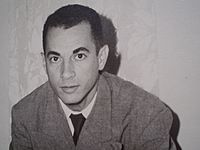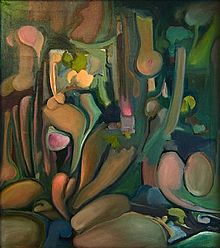José Bernal facts for kids
Quick facts for kids
José Bernal
|
|
|---|---|

José Bernal in 1952
|
|
| Born | January 8, 1925 Villa Clara, Cuba
|
| Died | April 19, 2010 (aged 85) Skokie, United States
|
| Nationality | Cuban-American |
| Education | Escuela de Artes Plásticas Leopoldo Romañach, Cuba, MFA, School of the Art Institute of Chicago, United States, MFA Evaluation |
| Known for | Painting, Collage, Assemblage |
| Movement | Postmodernism |
José Bernal Romero (born January 8, 1925 – died April 19, 2010) was a talented Cuban-American artist. He was born in Santa Clara, Cuba. Later, in 1980, he became a citizen of the United States.
Bernal's art was inspired by his Cuban background and his experiences of leaving his home country and starting fresh. His artwork is often described as modern, abstract, and expressive. Some also call his work postmodern because he didn't always try to create completely new art styles. Instead, he often used older ideas in new ways.
Contents
About José Bernal's Life
Growing Up in Cuba
As a child, José Bernal received private lessons in art and music. He finished Normal Teachers College in 1945. After that, he began teaching at different schools in the Las Villas province of Cuba. At the same time, he studied at the Escuela de Artes Plásticas Leopoldo Romañach. Here, he earned his MFA degree, which is a high-level art degree. His music and art were shown and performed in cities like Santa Clara and Havana.
In 1961, during a time of political trouble in Cuba called the Bay of Pigs Invasion, Bernal was arrested. He was held for eleven days because he refused to work cutting sugar cane. After he was released, he and his wife worried about their safety. They quietly started making plans to leave Cuba with their three young children. It took them more than a year to get the necessary papers to leave. With help from the Methodist Church, the Bernal family finally flew to the United States in June 1962.
Life in the United States
The Bernal family first arrived in Miami, Florida. However, they didn't stay long because it was hard to find jobs there. In the fall of 1962, they moved to Chicago, Illinois. José Bernal needed to support his family. Because of language differences, he found a job in a factory. He designed artistic materials for businesses. Even with this job, he kept creating his own personal art. Art experts noticed that his work changed after he moved. In Cuba, his paintings didn't use the bright colors of his homeland. But in Chicago, he started using the vibrant, tropical colors of the Caribbean in his art.
In 1964, Bernal showed his art to an executive at Marshall Field's, a large department store. He was offered a job as a Senior Designer there. The director of Field's art gallery then convinced Bernal to show his impressionist portraits, landscapes, and still lifes. Soon after, Betty Parsons, a famous art dealer and collector, discovered Bernal's work. She began ordering his paintings to show and sell them at Dayton's art galleries in Minneapolis. This successful connection allowed Bernal to leave his job at Marshall Field's. He could then go back to school to follow his dream of both teaching and painting.
After getting his MFA evaluation from the School of the Art Institute of Chicago in 1970, Bernal went back to teaching art. He also continued to create and show his artworks. An art critic named Lydia Murman wrote about Bernal's 1981 art show. She said his collages and assemblages made viewers think. She noted how he used everyday objects like wood, old newspapers, and metal. These objects made people feel a sense of history and meaning. Some of his works, like "Balancing the Unbalanced," used objects in a way that made viewers think about what is real and what is art.
During the 1980s, José Bernal started showing early signs of Parkinson's disease, though he didn't know it at the time. He was officially diagnosed in 1993. Despite his illness, he kept working and fighting against its effects. In 2004, Bernal gave many of his paintings to the National Parkinson Foundation in Miami, Florida. The foundation sold these artworks to raise money for their cause. Bernal's amazing gift included about 300 pieces of art.
Bernal's art is featured in two books by Dorothy Chaplik about Latin American art. In her essay "The Art of José Bernal," she writes about his entire body of work. She describes how he used his art to deal with life's challenges. These included political unrest in Cuba, his personal struggle with Parkinson's disease, and his strong passion for creating art.
José Bernal passed away on April 19, 2010, at his home in Skokie, Illinois. His death was due to problems from Parkinson's disease. Information about his life and art is kept in the Institute for Latino Studies at the University of Notre Dame in Indiana.
Museum Collections
José Bernal's artwork is part of the permanent collections in many museums, including:
- San Antonio Museum of Art, San Antonio, Texas
- Tucson Museum of Art and Historic Block, Tucson, Arizona
- Asheville Art Museum, Asheville, North Carolina
- Cameron Art Museum, Wilmington, North Carolina
- McNay Art Museum, San Antonio, Texas
- Mary and Leigh Block Museum of Art, Evanston, Illinois
- The Art Institute of Chicago, Chicago, Illinois
- Institute for Latino Studies/University of Notre Dame, Indiana
- Art Museum of the Americas, OAS, Washington, D.C.
- El Museo del Barrio, New York City
- DePaul Art Museum, Chicago, Illinois
- Loyola University Museum of Art, Chicago, Illinois
- Museo Nacional Centro de Arte Reina Sofía, Madrid, Spain
His art has also been featured in special shows that look back at his entire career, for example at:
See also
 In Spanish: José Bernal para niños
In Spanish: José Bernal para niños




